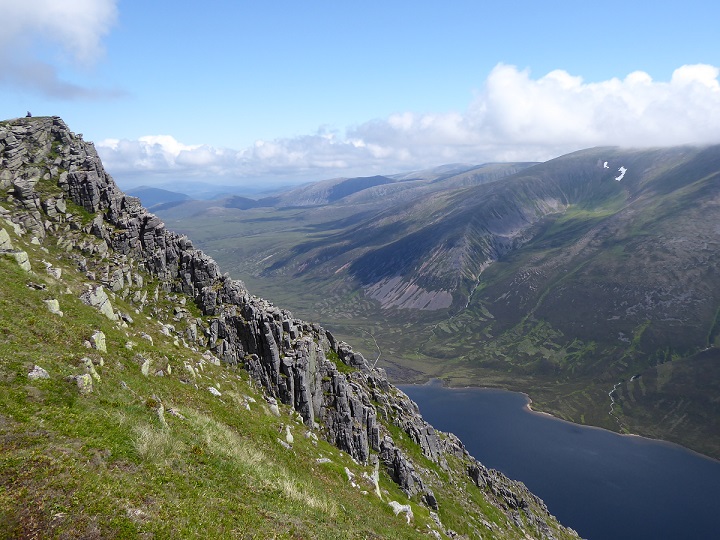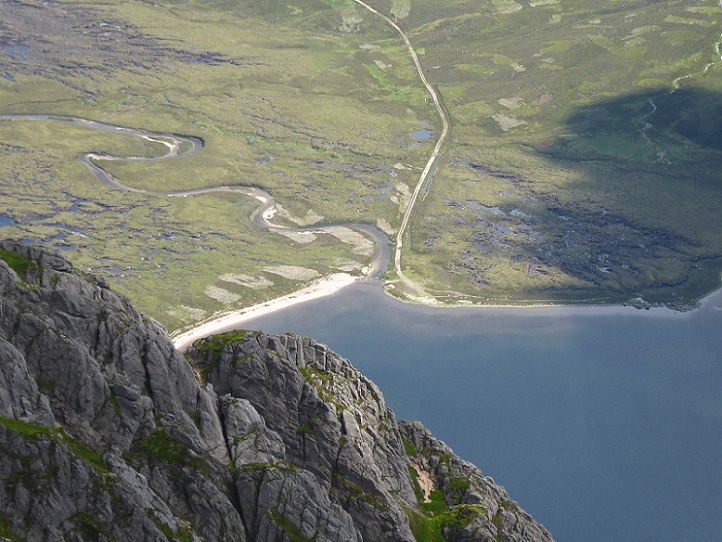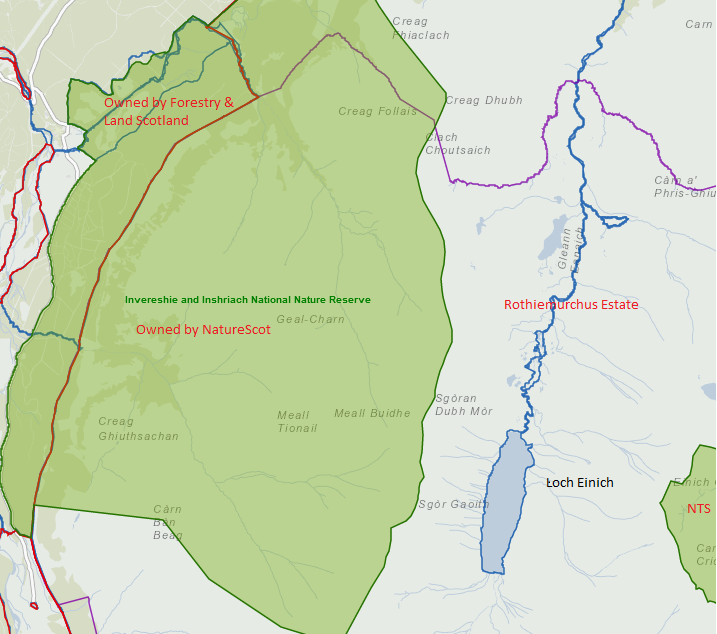
Rothiemurchus Estate has been split in two since it sold off the Caledonian Pine Forest in its middle section to Forestry Commission Scotland, as it then was, for £7.2m in 2016 (see here). The upper part, which extends to the head of Glen Einich, is sandwiched between the landholdings which have formed Cairngorms Connect and the Mar Lodge Estate owned by the National Trust for Scotland. All, are involved in major conservation and re-wilding initiatives. Yet near the geographical centre of all this good work, Rothiemurchus is managing a significant part of its landholding as a grouse moor and, as the photo shows, is practising extensive muirburn. Why are they being allowed to do this?

At the mouth of Loch Einich, muirburn is even being practised right next to an area of heavily eroded bog. Not clever!
The land owned by Rothiemurchus here is supposedly protected by many designations. Its in the Cairngorms Site of Special Scientific Interest, Cairngorms Special Area of Conservation (which protect habitats) and Cairngorms Special Protection Area (for birds). Loch Einich and the River Einich below are part of the River Spey Special Area of Conservation. Loch Einich itself is a Ramsar site (protected wetland). Its also in the Cairngorms National Scenic Area. It should therefore be one of the top priorities in Scotland for conservation management.
Where land has been designated as a SSSI, NatureScot considers what might damage the land and then produces a list of Operations Requiring Consent. By law, the landowner then has to get consent from NatureScot before doing these. The list for the Cairngorms SSSI (see here) includes “Burning” and “Game and Waterfowl Management and Hunting Practice”. One can only assume therefore that NatureScot, the main agency responsible for conservation in Scotland, doesn’t believe the muirburn taking place around the Einich is damaging and has granted permission for it.
If so, the incoherence in NatureScot’s thinking is striking. This is starkly illustrated by the difference between how they treat the land on Rothiemurchus and how they are managing their own land next door at Inshriach:
The land that NatureScot owns is part of Cairngorms Connect and the Inshriach and Invereshie National Nature Reserve (see here). While NatureScot’s revised plan for the Reserve (the consultation closed 3 years ago in May 2018) has not been published, their website states:

A natural sequence of habitats of habitats on one side of the boundary, intensive grouse moor management on the other. Besides converting vegetation into atmospheric carbon, the muirburn prevents the Caledonian Forest below from expanding up the hill, is preventing the peatbogs from expanding (and is almost certainly damaging them too), destabilises the river banks and is increasing the speed of water run-off into the Spey.
The final paragraph is correct to say the Insriach NNR s not an isolated site. But then why does NatureScot tolerate a landowner taking such a radically different approach to the land next door when it is designated and they have the power to intervene? The land owned by Rothiemurchus in Glen Einich should be at the core of the landscape scale project on the western side of the Cairngorms. But instead it is functioning as a hole at the heart of the National Park, bleeding other conservation initiatives.
The root of the problem is that for as long as I can remember NatureScot has not been prepared to use its statutory power to take on the Rothiemurchus estate and prevent them carrying out damaging land-management practices. It’s the same of course with other private landowners, from the Royal Family (see here) down. Indeed, the Rothiemurchus estate’s unwillingness to manage all its land according to the conservation objectives was one of the main reasons why the Cairngorms National Nature Reserve, which should have acted as the core conservation zone in the National Park, was abolished in 2006. Nothing has changed since.
With the climate and environment crises, there is no longer any excuse for this. This is not the fault of front-line staff, most of whom try their best against all odds, but it is a failure of leadership. NatureScot should be using its powers to stop the muirburn now, just as it should be using its powers to reduce deer numbers around Glen Banchor (see here) and the Cairngorms National Park Authority should be calling on it to do so.
Note
I have renamed this series of posts, based on what I saw during my stay up on Speyside last week, the state of the western Cairngorms. This reflects more accurately the area they cover. I hope to write a series on the state of the eastern Cairngorms in the future.
The Cairngorms National Nature Reserve came into being in 1954 comprising parts of Mar, Rothiemurchus, and Inshriach / Invereshie. Glen Feshie and Glen Avon were included later. One of the objectives of management was to manage the land with the minimum of human intervention and to this end a ‘no burning clause’ was part of the all the Nature Reserve Agreements and was strictly enforced and adhered too by the various landowners, including of course the land owned by the Nature Conservancy..
In short no heather burning was undertaken in Glen Eanaich between 1954 and 2006. This change in policy by SNH / Nature scot needs to be fully explained.
Brilliant, thank you! The scandal gets worse……………….
And the scandal includes persons engaged in criminal activity. The Nature Conservancy tried to purchase the whole of Glenfeshie Estate when it came up for sale in the late 1960s. A decision had been taken at the highest level in the NC to proceed to purchase when a Scottish Office civil servant intervened and the purchase was halted. It is believed this was to prevent the NC from opposing a prospective public road from Braemar to Aviemore to link into the newly constructed Aviemore Centre. The civil servant was George Pottinger. He was subsequently sent to jail, along with the architect of the Aviemore Centre, John Poulson, for corruption. And so Glenfeshie was bought by Lord Dulverton who had scant regard for bird protection legislation, hill track planning requirements and the natural regeneration of the Caledonian Pinewoods. This was the unacceptable face of private ownership in the Cairngorms.
and instructive to read dulverton’s attitude both to the ncc and afforestation of the flow country…
https://api.parliament.uk/historic-hansard/lords/1988/feb/17/nature-conservancy-council-1
Heavens – that was a revealing read. Depressing. I wonder if the level of debate has become more informed?
I was at this viewpoint (top picture) two years ago, after a long absence, and was surprised to see burning in such a formerly wild area. It looks to have been extended since then.
No doubt it will be thrilling for paying guests to shoot in such an environment, in the sure knowledge they are helping to protect, and even improve its biodiversity. Much like those who were ferried up the extended track on East Drumochter, not so many years ago, passing the pile of trap tunnels waiting to be deployed across the hill
What an essential aid to conservation these tracks are proving to be.
The decision to muirburn is more complex than this, with costs and benefits. The costs of muirburn have been laid out. The benefits of responsible muirburn in Glen Einich include:
• Improved habitat for ground nesting birds including red grouse which are a large part of the diet of golden eagles and other raptors
• Enhance the habitat for biodiversity
• Reduction in fuel for wildfires, especially important next to the Rothiemurchus Naturally Regenerated Pine Forest
• Income from grouse shooting supports a rural job and funds the maintenance of the track which many people enjoy using
We took the decision in 2008 to re-commence muirburn in Glen Einich. We regularly reconsider what we are doing as custodian of this iconic part of the Cairngorms and ensure we follow guidance from NatureScot
@Nick Kempe; it would be good to meet you. It’s often best to talk through things on the ground
When you wave your degree around you are supposed to name the university which granted you the qualification. Otherwise some may suppose that you either found it in a cornflakes box or purchased it from a dodgy backstreet institution.
No genuine qualified zoologist, such as myself for instance, would ever make such obviously false claims.
Please to be explaining how the poor benighted Grouse ever managed to survive in large enough numbers to support a thriving population of predators across half of Scotland without a single patch of muirburn?
Grouse shooting supports no jobs, it costs jobs. Every study ever conducted has proven this beyond any dispute. See also deerstalking.
Mountain Hare are a large part of the diet of Golden Eagles. Shame you and your horde slaughter them and have driven them to extinction on so many mountains.
The last research undertaken by E A Wilson before he headed off to die with Scott and Bowers was into Grouse populations. He showed that the major cause of decline was due to parasites. Parasite infestations that spread because the diseased birds were not removed from the population by predation but survived to spread disease. All the predators having been removed by you and your bloodthirsty mob.
Grouse moors proven to be bad for everything including the grouse you claim to care so much for. You’re no different to fish farms infesting everything with lice.
James Grant makes some amazing unsubstantiated claims. I too would like to see the alleged scientific reports on which he makes these claims.
If James Grant is correct, then the work being carried out by Cairngorms Connect must be in vain and consequently the results in biodiversity for example will just not be working! There is an excellent potential environmental project in studying the differences between Cairngorms Connect estates with the Rothiemurchus land in biodiversity and incidence of wildfires.
In my experience living in the Cairngorms, muirburn has been a significant cause of uncontrolled upland fires.
James did his degree at The University of Edinburgh – he collected data on Red Deer foraging habits that someone commented is worthy of a pHD – analysing the (stinking) contents of deers’ stomachs (from Glen Einich, Torridon, Jura?) under a microscope. In learning to identify what’l is in a deer’s stomach, and the habitat where it grows, he has a pretty good knowledge of the flora and fauna of Glen Einich.